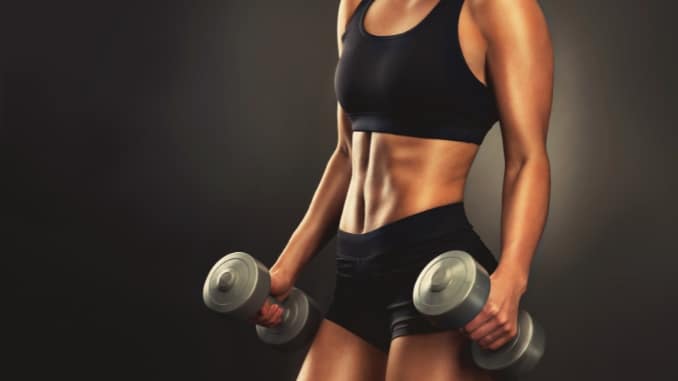When it comes to building strength, power, and versatility, the go-to for most athletes are dumbbell exercises like the db high pull for full power.
Dumbbells stand out as some of the most effective tools in the fitness world, offering endless exercise variations.
But with so many options to choose from, how do you decide which one deserves a spot in your routine?
If you’re looking for an exercise that boosts athleticism, enhances upper-body strength, and improves overall explosiveness, the db high pulls benefits and technique are worth understanding.
This movement not only develops power and coordination but also engages multiple muscle groups when performed correctly.
Similar to the upright row, the db high pull is an underrated yet powerful exercise that works multiple muscle groups simultaneously.
This makes it a go-to for athletes or anyone aiming to maximize results in minimal time.
Whether you’re an athlete wanting to improve performance or someone just looking to level up your fitness game, this dynamic movement delivers on all fronts.
In this article, we’ll explore the many benefits of the db high pull and break down the proper technique so you can add it to your routine with confidence.
Ready to power up your workout? Let’s dive in!
What is the Dumbbell High Pull?

The db high pull benefits and technique are essential to understand for maximizing performance and preventing injury.
This dynamic, compound exercise combines elements of strength and power training (Bubnis, 2020). It engages multiple muscle groups, including the shoulders, traps, legs, and core, making it an effective full-body movement.
At its core, the dumbbell high pull is designed to develop explosive force, improve coordination, and enhance overall athletic performance when performed with proper form.
This movement is particularly effective because it recruits multiple major muscle groups, including:
- Traps: Activated during the upward pull, helping to build stronger, broader shoulders.
- Shoulders: Specifically, the deltoids, which stabilize and assist in lifting the dumbbells.
- Glutes: Engaged during the hip extension phase, providing power and strength.
- Core: Actively stabilizes your body through movement, improving your balance and control.
One of the standout features of the db high pull is its versatility.
Unlike the barbell high pull, which requires more space and access to a barbell, dumbbells make this exercise accessible to just about anyone.
Whether you’re working out at home, in a crowded gym, or even in a small apartment, dumbbells allow for greater freedom of movement and are easier to manage, especially for beginners.
Here’s How To Do Dumbbell High Pulls
- Begin in an upright position with your feet hip-width apart, maintaining good alignment of your head, shoulders, hips, and legs.
- Hold a dumbbell in each hand with your arms hanging down in front of you, palms facing your body.
- Bend your knees and hinge through your hips to bring your upper body forward.
- Engage your core and bend your elbows to pull the dumbbells up towards your shoulders as you push through your hips and knees to keep your spine straight.
- Slowly lower them back down to the starting position and repeat the movement as needed.
Dumbbell High Pull Exercise Techniques
1. Single Arm Dumbbell High Pull
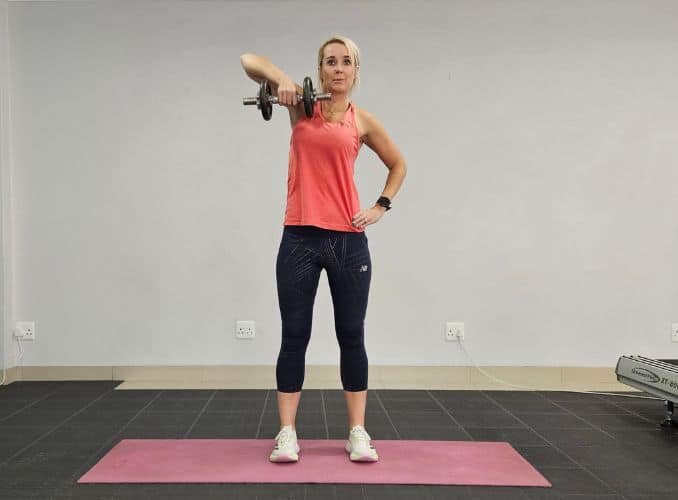
- Begin in an upright standing position with your feet hip-width apart, maintaining good alignment with your head, shoulders, hips, and legs.
- Hold a dumbbell in one hand while you place your opposite hand on your hip.
- Engage your core and raise your arm to lift the dumbbell at shoulder level.
- Hold the position for a couple of seconds, then relax and lower your arm down. Repeat the movement on the opposite side.
2. Kettlebell High Pull
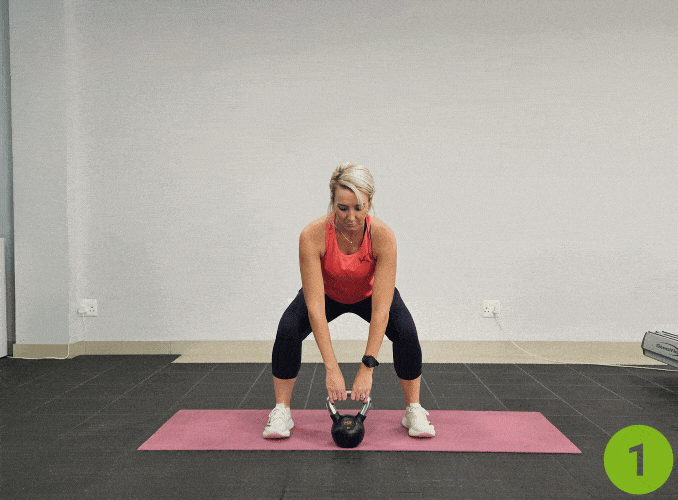
- Begin in an upright standing position in front of a kettle, with your feet wider than shoulder-width apart.
- Maintain good alignment with your head, shoulders, and hips.
- Engage your core. Bend your knees and hinge through your hips to pick up the kettlebell with both hands.
- Then, stand back in an upright position with the kettlebell between your legs while keeping your spine straight.
- Slowly raise your arms up, bringing the kettlebell to chest level, as you bend your elbows to the side, forming a V shape.
- Hold the position for a couple of seconds then lower your arms down to return to the starting position. Repeat the sequence of movement with 5-10 repetitions.
3. Barbell High Pull
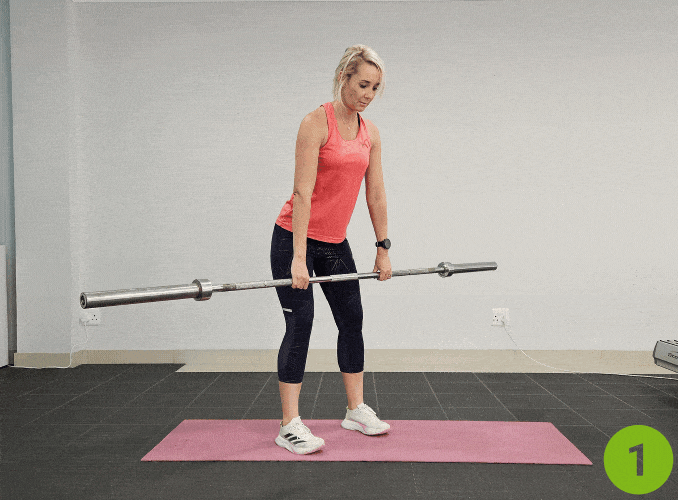
- Begin in an upright standing position with your feet wider than shoulder-width apart.
- Maintain good alignment with your head, shoulders, and hips.
- Hold a barbell with both hands. Engage your core and lift your heels up as you raise your arms at chest level.
- Hold the position for a couple of seconds then lower your arms down to return to the starting position. Repeat the sequence of movement with 5-10 repetitions.
4. Resistance Band High Pull
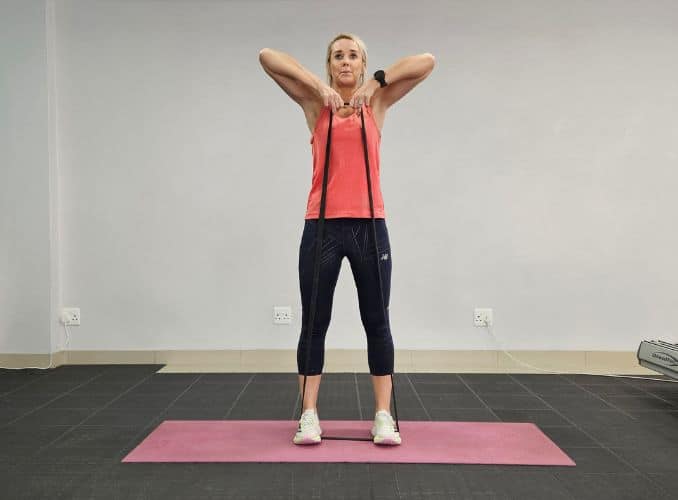
- Begin in an upright standing position with your feet shoulder-width apart.
- Maintain good alignment with your head, shoulders, and hips.
- Step on the center of the band and slowly pull the other ends with both hands at chest level, as you bend your elbows to the side, forming a V shape.
- Hold the position for several deep belly breaths, in through your nose and out through your mouth. Lower your arms down and repeat the movement.
5. Reach and Pull
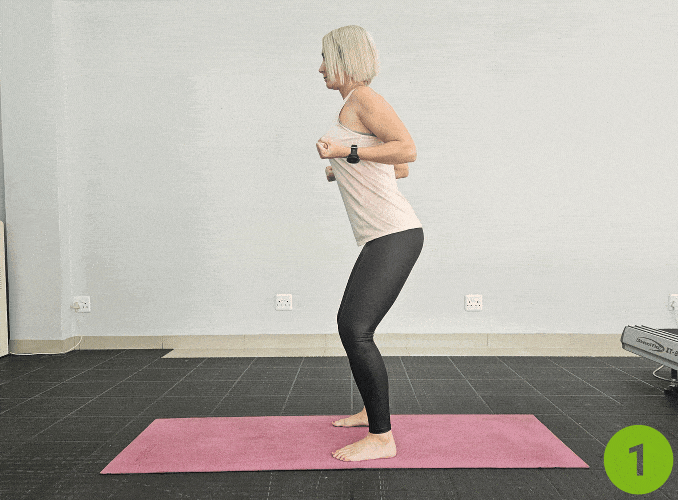
- Begin in an upright standing position with your feet shoulder-width apart, maintaining good alignment with your head, shoulders, hips, and legs.
- Engage your core. Extend both arms in front of your body at shoulder height and bend your knees slightly.
- Pull your arms back, keeping your elbows in line with your shoulders and squeezing your shoulder blades together at the end position.
- Return to the starting position and repeat the movement.
Key Benefits of Dumbbell High Pull

The db high pull is more than just a simple exercise—it’s a powerhouse movement that delivers a wide range of benefits for anyone looking to enhance their fitness.
By combining strength, power, and coordination, this exercise engages multiple muscle groups, making it a valuable addition to any workout routine.
Let’s break down the db high pull benefits and technique to understand how it can improve strength, boost athletic performance, and refine movement efficiency.
1. Strength Development
The dumbbell high pull is a compound movement [2], meaning it engages multiple muscle groups simultaneously
It targets the upper body—primarily the traps, shoulders, and arms—while also activating the posterior chain, including the glutes, hamstrings, and lower back.
This makes it an excellent exercise for building both pulling strength and overall muscular endurance.
Over time, consistently performing dumbbell high pulls exercise will lead to stronger, more defined muscles and a solid foundation for other strength-based exercises.
2. Improved Athletic Performance

Explosive power is essential for athletes in sports like basketball, soccer, and football—and the db high pull delivers.
The quick, controlled pulling motion closely mimics the explosive movements needed in many athletic activities, such as jumping, sprinting, or changing directions.
Incorporating dumbbell high pulls into your training routine can help you generate more force effectively, improving both your power and speed on the field or court.
3. Versatility
One of the biggest benefits and techniques of the db high pull is its adaptability.
It’s suitable for people of all fitness levels, from beginners to advanced lifters.
You can easily adjust the intensity by selecting lighter or heavier dumbbells based on your goals.
Beginners can start with lighter weights to perfect their form, while experienced athletes can push their limits with heavier loads to maximize strength and power.
Additionally, dumbbells allow for a wider range of motion than a barbell, making the movement more flexible and less restrictive.
4. Core Stability

Performing a db high pull requires strong core engagement to stabilize your body throughout the movement. This is one of the key dumbbell high pull benefits and technique aspects.
As you hinge at the hips and drive the dumbbells upward, your core must work hard to maintain balance and prevent unnecessary twisting or leaning.
Over time, this helps improve your posture, balance, and overall functional strength, making it easier to perform daily activities and other exercises with proper form.
5. Low Equipment Requirement
Unlike some gym exercises that require specialized machines or a fully equipped gym, the dumbbell high pull can be done with just a pair of dumbbells.
This makes it an excellent option for home workouts, especially if space or equipment is limited.
Whether you’re training in your living room, garage, or hotel room, all you need is a small area and a set of dumbbells to perform this effective exercise.
Common Mistakes to Avoid

The db high pull is an effective exercise, but improper form can reduce its benefits and increase the risk of injury.
The dumbbell high pull is an effective exercise, but improper form can reduce its db high pulls benefits and technique and increase the risk of injury.
Here are the most common mistakes people make with the dumbbell high pull and actionable tips to correct them.
1. Using Too Much Weight
One of the most frequent mistakes is going too heavy too soon.
While it may seem tempting to grab the heaviest dumbbells you can lift, using excessive weight often compromises your form.
This can lead to poor execution, such as jerking the dumbbells or failing to engage the correct muscles.
Overloading also increases the likelihood of shoulder strain or lower back injuries.
How to Fix It:
- Start with lighter dumbbells to master the movement pattern and focus on proper technique.
- Gradually increase the weight as your strength improves.
- Remember, quality over quantity—form always trumps the amount of weight lifted.
2. Over-reliance on Arms Instead of Hips and Legs
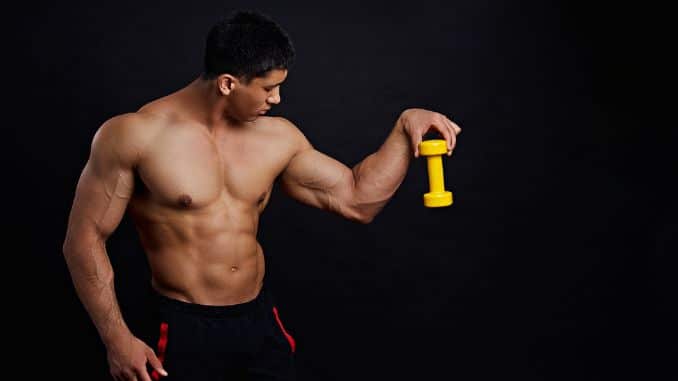
The db high pulls is a full-body exercise, but many people mistakenly rely solely on their arms to pull the weight.
This not only limits the movement’s power but also places undue stress on the shoulders.
The real power of this exercise comes from the explosive extension of your hips and legs, not just the pull from your arms.
How to Fix It:
- Focus on initiating the movement from your hips and driving through your legs.
- Practice the hip hinge movement separately to build awareness of your posterior chain engagement.
- Imagine the upward pull as a continuation of the explosive power generated by your hips and legs, with your arms simply guiding the dumbbells upward.
3. Rushing the Movement
Performing the dumbbell high pull too quickly is another common mistake.
Rushing the movement often results in poor control, reduced muscle engagement, and a higher risk of injury.
Without proper pacing, you may also lose the explosive power that makes this exercise effective.
How to Fix It:
- Slow down and prioritize control over speed. The movement is controlled on the way down.
- Use a tempo: one count for the pull and two counts for the descent phase.
- Focus on engaging your core to stabilize your body and prevent wobbling during the movement.
Safety Tips and Precautions

The dumbbell high pull is a fantastic exercise like the dumbbell high pull without a proper warm-up is a recipe for muscle strain or injury.
Taking the right precautions ensures you minimize injury risk while maximizing your results.
Here’s what you need to know to stay safe and get the most out of your workout.
1. Importance of Warming Up
Jumping straight into a dynamic exercise like the dumbbell high pull without a proper warm-up is a recipe for muscle strain or injury.
This movement requires your shoulders, hips, and core to work together explosively, which means your muscles and joints need to be primed for action.
2. When to Avoid the Exercise
While the dumbbell high pull is highly effective, it’s not suitable for everyone.
Certain injuries or physical limitations can make this exercise risky or counterproductive.
If you have any of the following conditions, consider avoiding the dumbbell high pull or consulting a healthcare professional or trainer before performing it.
3. Start with Light Weights to Master Form
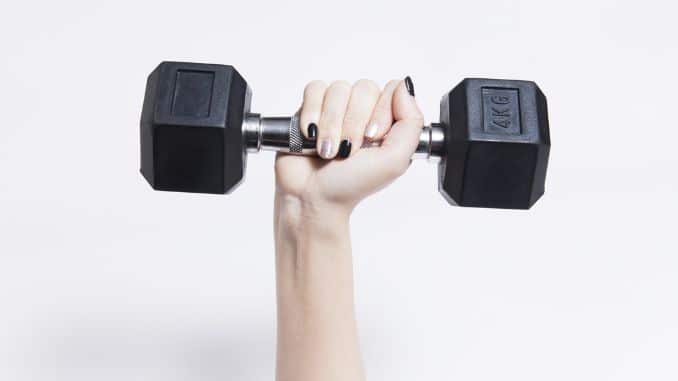
One of the most critical safety tips for the dumbbell high pull is to prioritize technique over intensity.
Starting with heavy weights before mastering the proper form can lead to bad habits, reduced effectiveness, and a higher likelihood of injury.
Overall, according to the nationally certified personal trainer, Daniel Bubnis [1], this exercise works on multiple muscle groups allowing you to do more explosive movements as you progress. Not only that but it also helps you build muscle mass and boosts energy in the process.
Conclusion
The dumbbell high pull is a dynamic, versatile exercise that packs a punch when it comes to building strength, power, and overall fitness. Its dumbbell high pull benefits and technique make it a valuable addition to any workout routine.
Targeting multiple muscle groups—such as the traps, shoulders, glutes, hamstrings, and core—not only enhances upper-body and posterior chain strength but also improves explosive power and athletic performance.
Its adaptability makes it suitable for all fitness levels, whether you’re just starting your fitness journey or are an experienced lifter looking to refine your routine.
With minimal equipment required, the dumbbell high pull is perfect for home workouts or crowded gyms.
Incorporating proper techniques is a must to avoid common mistakes.
Essential safety precautions like warming up and starting with lighter weights can help maximize the benefits of this powerful movement while minimizing injury risk.
Whether your goal is to boost athleticism, increase strength, or add a functional, full-body exercise to your regimen, the dumbbell high pull delivers.
Now it’s your turn—grab a pair of dumbbells, master the technique, and experience the transformative benefits of this underrated exercise.
Start incorporating it into your workout routine today, and watch as your fitness reaches new heights!
As we age, the stakes are higher—your health, mobility, and well-being depend on how you treat your body. Check out this Tone and Tighten Dumbbell Workout now!
Frequently Asked Questions
Can dumbbell high pulls help with weight loss?
Yes, dumbbell high pulls can support weight loss when incorporated into a high-intensity workout or circuit training.
This exercise burns calories by engaging multiple muscle groups and elevating your heart rate, especially when performed explosively or in a timed interval format.
How often should I include dumbbell high pulls in my workout routine?
The frequency depends on your fitness goals.
For general strength and power development, 2–3 times per week is sufficient, with at least one day of rest between sessions to allow for recovery.
If you’re focusing on improving explosiveness, you might include them as part of your lower-body or full-body training days.
Are dumbbell high pulls safe for older adults?
Dumbbell high pulls can be safe for older adults with good mobility and no pre-existing shoulder or joint issues.
It’s recommended to use lighter weights and focus on slow, controlled movements to reduce the risk of injury.
Not only that, but it also improves the posterior chain muscles and other muscle groups as you get better and better.
Can dumbbell high pulls be used as a warm-up exercise?
Yes, dumbbell high pulls can serve as a warm-up if performed with very light weights to activate the traps, shoulders, glutes, and core.
Doing 2–3 sets of 10–12 reps at low intensity can help prepare your body for more challenging exercises later in the workout.
Do dumbbell high pulls improve grip strength?
While dumbbell high pulls aren’t primarily designed to improve grip strength, they can provide some benefits, especially if heavier dumbbells are used.
For a more focused grip improvement, try out different grips when exercising like the pinch, pronated, and overhand grip.
Not only that, but it also improves the posterior chain muscles and other muscle groups as you get better and better.

